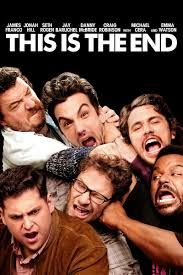
Analyzing acting styles in “This is The End” is a fun assignment because in this film, the actors played themselves. This insanely funny, “R” rated comedy is a story of six friends trapped in James Franco’s house. The night started out as a party and concluded with the beginning of the end of the world. Nothing tests friendships more than surviving an apocalypse.
Three of the stars who made this movie as wild as it was include Seth Rogen, who also directed it, Jonah Hill, and Craig Robinson. I consider all three of them personality actors. In every movie I’ve seen them in, they seem to play the same kind of character. Seth always seems to play a role of an immature man who enjoys recreational marijuana use. He seems to always lack motivation and ambition, yet people like him because he’s an overall nice enough guy. In “Knocked Up” he was clearly not ready to be a parent, but it was so hard to hate him because his character seems to mean well and eventually makes an effort to prove himself to the mother of his child.
Jonah Hill is the same overweight, timid, easily forgettable kind of man that seems to be taken advantage of in every film I’ve seen him in. In “This is The End,” Jay hated him and yelled at him for what seemed to be no reason at all. In “Get Him to the Greek,” he played a lowly intern who was repeatedly overlooked and ignored by other characters in the movie.
Craig Robinson is a massive black guy that always seems to get pulled into drama because of the antics of his friends. He plays roles like club bouncers, enforcers, etc. Same guy in every film…
Leaving these actors in their comfort zone of basically acting like themselves will most likely continue to be a successful move for them and the directors who use them in films. It works. Although it may hint at their inability to grow and mature in their field and perform in a different role, there’s really nothing wrong with sticking to roles they’ve already established themselves in. If it works, it works. I’ll keep watching!
Goodykoontz, B., & Jacobs, C. P. (2011). Film: From Watching to Seeing. San Diego: Bridgepoint Education, Inc.
This Is the End. (2013). Retrieved May 15, 2014, from IMDb: http://www.imdb.com/title/tt1245492/?ref_=nv_sr_1
See the trailer here:


